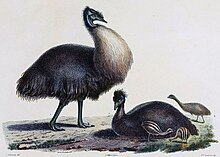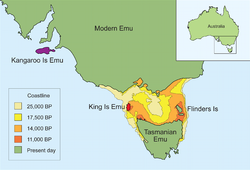Dromaius baudinianus
| Kangaroo Island emu | |
|---|---|
 |
|
| Illustration by Charles-Alexandre Lesueur, based on life-drawings made during Baudin's journey and specimens kept at Jardin des Plantes. The animals were thought to be a male and female of the same species, but are possibly a Kangaroo Island emu and King Island emu | |
| Scientific classification | |
| Kingdom: | Animalia |
| Phylum: | Chordata |
| Class: | Aves |
| Superorder: | Paleognathae |
| Order: | Casuariiformes |
| Family: | Dromaiidae |
| Genus: | Dromaius |
| Species: | †D. baudinianus |
| Binomial name | |
|
Dromaius baudinianus Parker, 1984 |
|
 |
|
| Geographic distribution of emu taxa and historic shoreline reconstructions around Tasmania, D. baudinianus in purple | |
| Synonyms | |
|
Casuarius diemenianus Jennings,1827 |
|
Casuarius diemenianus Jennings,1827
Dromaius parvulus Mathews,1901
Peronista diemenianus Mathews,1927
Kangaroo Island emu or dwarf emu (Dromaius baudinianus) is an extinct member of the bird family Dromaiidae. It was restricted to Kangaroo Island, South Australia, which was known as Ile Decrés by the members of the Baudin expedition. It differed from the mainland emu mainly in its smaller size. The species became extinct by about 1827.
It was discovered in 1802 by Matthew Flinders and reported to be quite common around Nepean Bay. The first bones of the species were discovered in 1903 at The Brecknells, sandhills on the west side of Cape Gantheaume. Initially there was confusion regarding the taxonomic status and geographic origin of the Kangaroo Island emu, particularly with respect to their relationship to King Island emu, which were also transported to France as part of the same expedition. The expeditions logbooks failed to clearly state where and when dwarf emu individuals were collected. This led to both taxa being interpreted as a single taxon and that it originated from Kangaroo Island. More recent finds of sub-fossil material and subsequent studies on King and Kangaroo Island emu confirm their separate geographic origin and distinct morphology.
In his 1907 book Extinct Birds, Walter Rothschild claimed Vieillot's description actually referred to the mainland emu, and that the name D. ater was therefore preoccupied. Believing the skin in Muséum national d'Histoire naturelle of Paris was from Kangaroo Island, he made it the type specimen of his new species Dromaius peroni, named after the French naturalist François Péron, who is the main source of information about the bird in life. The Australian amateur ornithologist Gregory Mathews coined further names in the early 1910s, including a new genus name, Peronista, as he believed the King and Kangaroo Island birds were generically distinct from the mainland emu. Later writers claimed that the subfossil remains found on King and Kangaroo Islands were not discernibly different, and that they therefore belonged to the same taxon. In 1959, the French ornithologist Christian Jouanin proposed that none of the skins were actually from Kangaroo Island. In 1990, Jouanin and Jean-Christophe Balouet demonstrated that the mounted skin in Paris came from King Island, and that at least one live bird had been brought from each island. All scientific names given to the Kangaroo Island emu were therefore based on specimens from King Island or were otherwise invalid, leaving it nameless. More recent finds of sub-fossil material and subsequent studies on King and Kangaroo Island emu, notably by Shane A. Parker in 1984, confirmed their separate geographic origin and distinct morphology. Parker named the Kangaroo Island bird Dromaius baudinianus, after the leader of the French expedition. He based it on a sub-fossil specimen from Kangaroo Island, South Australia. Specimen SAM B689Ib, a left tarsometatarsus, is the holotype.
...
Wikipedia

